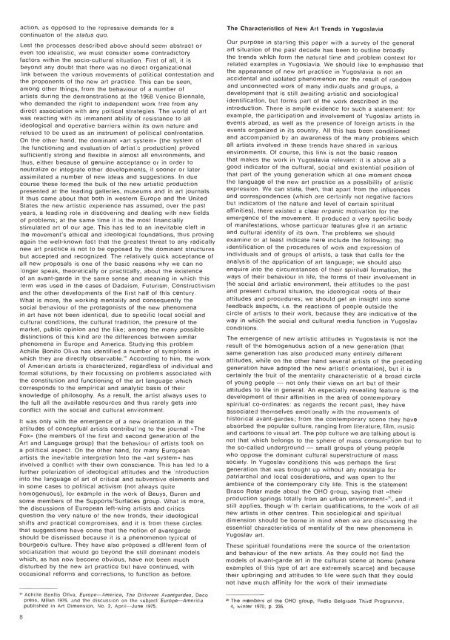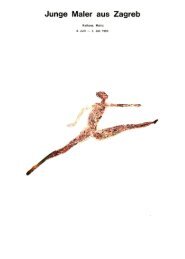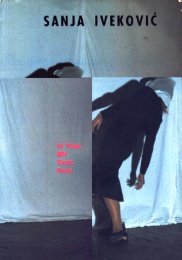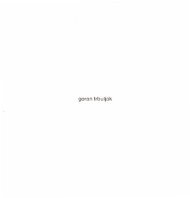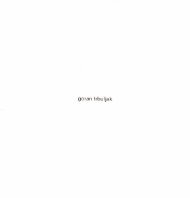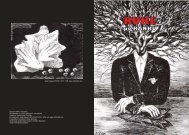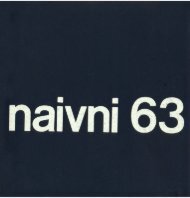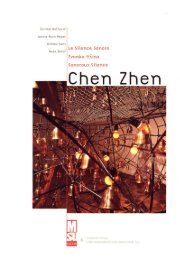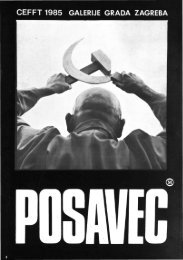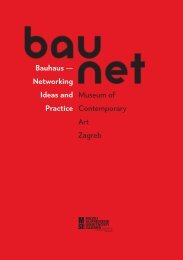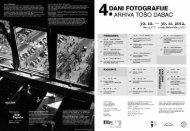The New Art Practice in Yugoslavia, 1966-1978
The New Art Practice in Yugoslavia, 1966-1978
The New Art Practice in Yugoslavia, 1966-1978
- TAGS
- practice
- yugoslavia
- www.msu.hr
Create successful ePaper yourself
Turn your PDF publications into a flip-book with our unique Google optimized e-Paper software.
action, as opposed to the repressive demands for a<br />
cont<strong>in</strong>uaton of the status quo.<br />
Lest the processes described above should seem abstract or<br />
even too idealistic, we must consider some contradictory<br />
factors with<strong>in</strong> the socio-cultural situation. First of all, it is<br />
beyond any doubt that there was no direct organizational<br />
l<strong>in</strong>k between the various movements of political contestation and<br />
the proponents of the new art practice. This can be seen,<br />
among other th<strong>in</strong>gs, from the behaviour of a number of<br />
artists dur<strong>in</strong>g the demonstrations at the 1968 Venice Biennale,<br />
who demanded the right to <strong>in</strong>dependent work free from any<br />
direct association with any poitical strategies. <strong>The</strong> world of art<br />
was react<strong>in</strong>g with its immanent ability of resistance to all<br />
ideological and operative barriers with<strong>in</strong> its own nature and<br />
refused to be used as an <strong>in</strong>strument of political confrontation.<br />
On the other hand, the dom<strong>in</strong>ant «art system. (the system of<br />
the function<strong>in</strong>g and evaluation of artist'c production) proved<br />
sufficiently strong and flexible <strong>in</strong> almost all environments, and<br />
thus, either because of genu<strong>in</strong>e acceptance or <strong>in</strong> order to<br />
neutralize or <strong>in</strong>tegrate other developments, it sooner or later<br />
assimilated a number of new ideas and suggestions. In due<br />
course these formed the bulk of the new artistic production<br />
presented at the lead<strong>in</strong>g galleries, museums and <strong>in</strong> art journals.<br />
It thus came about that both <strong>in</strong> western Europe and the United<br />
States the new artistic experience has assumed, over the past<br />
years, a lead<strong>in</strong>g role <strong>in</strong> discover<strong>in</strong>g and deal<strong>in</strong>g with new fields<br />
of problems; at the same time it is the most f<strong>in</strong>ancially<br />
stimulated art of our age. This has led to an <strong>in</strong>evitable cleft <strong>in</strong><br />
the movement's ethical and ideological foundations. thus prov<strong>in</strong>g<br />
aga<strong>in</strong> the well-known fact that the greatest threat to any radically<br />
new art practice is not to be opposed by the dom<strong>in</strong>ant structures<br />
but accepted and recognized. <strong>The</strong> relatively quick acceptance of<br />
all new proposals is one of the basic reasons why we can no<br />
:onger speak, theoretically or practically. about the existence<br />
of an avant-garde <strong>in</strong> the same sense and mean<strong>in</strong>g <strong>in</strong> which this<br />
term was used <strong>in</strong> the cases of Dadaism, Futurism, Constructivism<br />
and the other developments of the first half of this century.<br />
What is more, the work<strong>in</strong>g mentality and consequently the<br />
social behaviour of the protagonists of the new phenomena<br />
<strong>in</strong> art have not been identical, due to specific local social and<br />
sultural cond:tions, the cultural tradition. the presure of the<br />
market, public op<strong>in</strong>ion and the like; among the many possible<br />
dist<strong>in</strong>ctions of this k<strong>in</strong>d are the differences between similar<br />
phenomena <strong>in</strong> Europe and America. Study<strong>in</strong>g this problem<br />
Achille Bonito Oliva has identified a number of symptoms <strong>in</strong><br />
which they are directly observable. Accord<strong>in</strong>g to him, the work<br />
of American artists is characterized, regardless of <strong>in</strong>dividual and<br />
formal solutions, by their focuss<strong>in</strong>g on problems associated with<br />
the constitution and function<strong>in</strong>g of the art language which<br />
corresponds to the empirical and analytic basis of their<br />
knowledge of philosophy. As a result, the artist always uses to<br />
the full all the available resources and thus rarely gets <strong>in</strong>to<br />
conflict with the social and cultural environment.<br />
It was only with the emergence of a new orientation <strong>in</strong> the<br />
attitudes of conceptual artists contribut.ng to the journal «<strong>The</strong><br />
Fox. (the members of the first and second generation of the<br />
<strong>Art</strong> and Language group) that the behaviour of artists took on<br />
a political aspect. On the other hand, for many European<br />
artists the <strong>in</strong>evitable <strong>in</strong>tergration <strong>in</strong>to the «art system» has<br />
<strong>in</strong>volved a conflict with their own conscience. This has led to a<br />
further polarization of ideological attitudes and the ntroduction<br />
<strong>in</strong>to the language of art of critical and subversive elements and<br />
<strong>in</strong> some cases to political activism (not always quite<br />
homogenuous), for example <strong>in</strong> the work of Beuys. Buren and<br />
some members of the Supports Surfaces group. What is more,<br />
the discussions of European left-w<strong>in</strong>g artists and critics<br />
question the very nature of the new trends, their ideological<br />
shifts and practical compromises, and it is from these circles<br />
that suggestions have come that the notion of avantgarde<br />
should be dismissed because it is a phenomenon typical of<br />
bourgeois culture <strong>The</strong>y have also proposed a different form of<br />
socialization that would go beyond the still dom<strong>in</strong>ant models<br />
which, as has now become obvious, have not been much<br />
disturbed by the new art practice but have cont<strong>in</strong>ued, with<br />
occasional reforms and corrections, to function as before.<br />
W Achille Bonito Oliva, EuropeAmerica, <strong>The</strong> Different Avantgardes, Deco<br />
press. Milan 1976, and the discussion on the subject Europe-America<br />
published <strong>in</strong> <strong>Art</strong> Dimension, No, 2. AprilJune 1975.<br />
8<br />
<strong>The</strong> Characteristics of <strong>New</strong> <strong>Art</strong> Trends <strong>in</strong> <strong>Yugoslavia</strong><br />
Our purpose <strong>in</strong> start<strong>in</strong>g this paper with a survey of the general<br />
art situation of the past decade has been to outl<strong>in</strong>e broadly<br />
the trends which form the natural time and problem context for<br />
related examples <strong>in</strong> <strong>Yugoslavia</strong>. We should like to emphasise that<br />
the appearance of new art practice <strong>in</strong> <strong>Yugoslavia</strong> is not an<br />
accidental and isolated phenomenon nor the result of random<br />
and unconnected work of many <strong>in</strong>div.duals and groups, a<br />
development that is still await<strong>in</strong>g artistic and sociological<br />
identification, but forms part of the work described <strong>in</strong> the<br />
<strong>in</strong>troduction. <strong>The</strong>re is ample evidence for such a statement: for<br />
example, the participation and <strong>in</strong>volvement of Yugoslav artists <strong>in</strong><br />
events abroad, as well as the presence of foreign artists <strong>in</strong> the<br />
events organized <strong>in</strong> its country. All this has been conditioned<br />
and accompanied by an awareness of the many problems which<br />
all artists <strong>in</strong>volved <strong>in</strong> these trends have shared <strong>in</strong> various<br />
environments. Of course, this l<strong>in</strong>k is not the basic reason<br />
that makes the work <strong>in</strong> <strong>Yugoslavia</strong> relevant: it is above all a<br />
good <strong>in</strong>dicator of the cultural, social and existential position of<br />
that part of the young generation which at one moment chose<br />
the language of the new art practice as a possibility of artistic<br />
expression. We can state, then, that apart from the <strong>in</strong>fluences<br />
and correspondences (which are certa<strong>in</strong>ly not negative factors<br />
but <strong>in</strong>dicators of the nature and level of certa<strong>in</strong> spiritual<br />
aff<strong>in</strong>ities), there existed a clear organic motivation for the<br />
emergence of the movement. It produced a very specific body<br />
of manifestations, whose particuar features give it an artistic<br />
and cultural identity of its own. <strong>The</strong> problems we should<br />
exam<strong>in</strong>e or at least <strong>in</strong>dicate here <strong>in</strong>clude the follow<strong>in</strong>g: the<br />
identification of the procedures of work and expression of<br />
<strong>in</strong>dividuals and of groups of artists, a task that calls for the<br />
analysis of the application of art language; we should also<br />
enquire <strong>in</strong>to the circumstances of their spiritual formation, the<br />
ways of their behaviour <strong>in</strong> life, the forms of their <strong>in</strong>volvement <strong>in</strong><br />
the social and artistic environment, their attitudes to the past<br />
and present cultural situaton, the ideological roots of their<br />
attitudes and procedures; we should get an <strong>in</strong>sight <strong>in</strong>to some<br />
feedback aspects, i.e. the reactions of people outside the<br />
circle of artists to their work, because they are <strong>in</strong>dicative of the<br />
way <strong>in</strong> which the social and cultural media function <strong>in</strong> Yugoslav<br />
conditions.<br />
<strong>The</strong> emergence of new artistic attitudes <strong>in</strong> <strong>Yugoslavia</strong> is not the<br />
result of the homogenuous action of a new generation (that<br />
same generation has also produced many entirely different<br />
attitudes, while on the other hand several artists of the preced<strong>in</strong>g<br />
generation have adopted the new artist.c orientation), but it is<br />
certa<strong>in</strong>ly the fruit of the mentality characteristic of a broad circle<br />
of young people not only their views on art but of their<br />
attitudes to life <strong>in</strong> general. An especially reveal<strong>in</strong>g feature is the<br />
development of their aff<strong>in</strong>ities <strong>in</strong> the area of contemporary<br />
spiritual co-ord<strong>in</strong>ates: as regards the recent past, they have<br />
associated themselves emot'onally with the movements of<br />
historical avant-gardes: from the contemporary scene they have<br />
absorbed the popular culture, rang<strong>in</strong>g from literature, film, music<br />
and cartoons to visual art. <strong>The</strong> pop culture we are talk<strong>in</strong>g about is<br />
not that which belongs to the sphere of mass consumption but to<br />
the so-called underground small groups of young people<br />
who oppose the dom<strong>in</strong>ant cultural superstructure of mass<br />
society. In Yugoslav conditions this was perhaps the first<br />
generation that was brought up without any nostalgia for<br />
patriarchal and local cosiderations, and was open to the<br />
ambience of the contemporary city life. This is the statement<br />
Braco Rotar made about the OHO group, say<strong>in</strong>g that «their<br />
production spr<strong>in</strong>gs totally from an urban environment.', and it<br />
still applies, though w'th certa<strong>in</strong> qualifications, to the work of all<br />
new artists <strong>in</strong> other centres. This sociological and spiritual<br />
dimension should be borne <strong>in</strong> m<strong>in</strong>d when we are discuss<strong>in</strong>g the<br />
essential characteristics of mentality of the new phenomena <strong>in</strong><br />
Yugoslav art.<br />
<strong>The</strong>se spiritual foundations were the source of the orientation<br />
and behaviour of the new artists. As they could not f<strong>in</strong>d the<br />
models of avant-garde art <strong>in</strong> the cultural scene at home (where<br />
examples of this type of art are extremely scarce) and because<br />
their upbr<strong>in</strong>g<strong>in</strong>g and attitudes to life were such that they could<br />
not have much aff<strong>in</strong>ity for the work of their immediate<br />
20 <strong>The</strong> members of the OHO group. Radio Belgrade Third Programme.<br />
4, w<strong>in</strong>ter 1970. p, 235.


